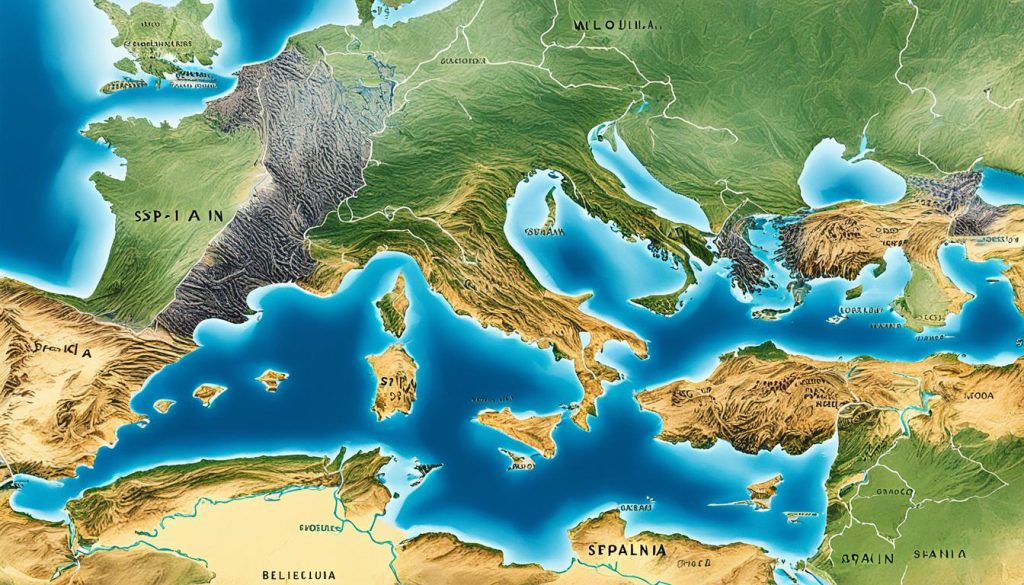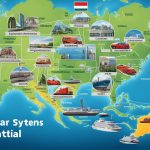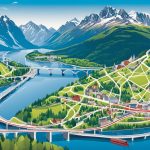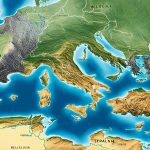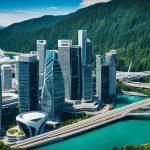Exploring European geography reveals Spain, Belgium, and the Nordic Countries each offer unique scenes. Spain pleases with its varied landscapes, from mountains to coastlines, creating diverse weather patterns. Belgium shines with its prime location in Western Europe, boasting superb connectivity and transport links.
The Nordic journey through Iceland, Finland, Norway, Sweden, and Denmark unveils a blend of natural beauty and sturdy infrastructures. These countries show how to use their natural assets to build sustainable systems. It’s a look into how landscapes and urban development work together, showcasing innovation and resilience.
Geographical Diversity Across Spain, Belgium and Nordic Countries
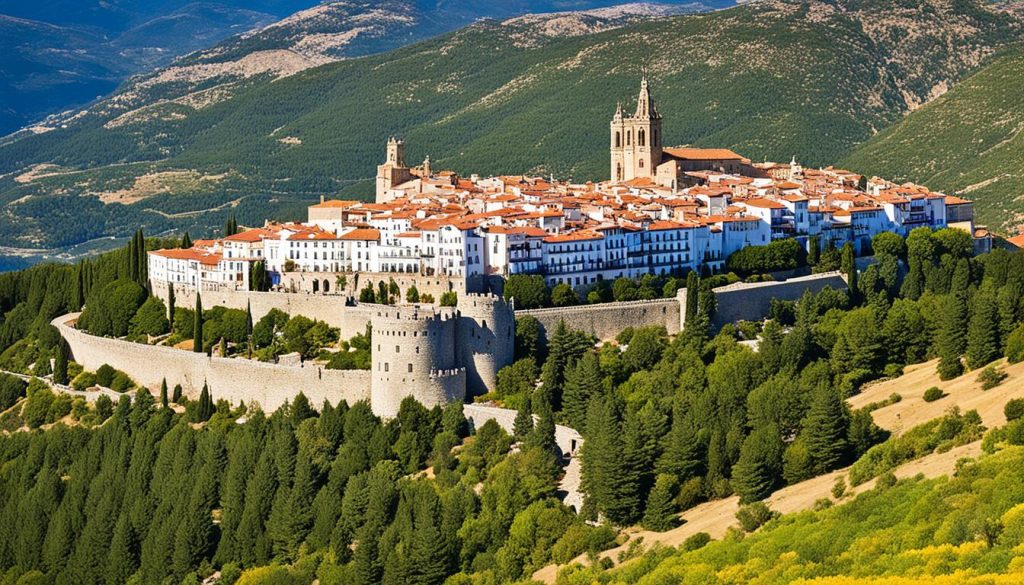
Europe’s topography is like a colourful patchwork quilt. Each region has unique features and natural beauty. From Spain’s sunny lands to Belgium’s rolling hills and the striking landscapes of the Nordic countries, this variety shows Europe’s true spirit.
Understanding the Iberian Peninsula: Spain’s Landscape
Spain covers most of the Iberian Peninsula with diverse landscapes. Key features include the Pyrenees, the Sierra Nevada, and the Meseta Plateau. Mountains and rivers create different climates, affecting culture and economy.
Belgium’s Position in Western Europe
Belgium, though smaller, is crucial in Western Europe’s layout. Its flat lands and hills are strategic for connections and trade. Rivers like the Scheldt and Meuse boost its economy and movement.
Topographical Contrasts Among the Nordic Nations
- Norway’s coastline features fjords and rugged areas, making infrastructure a challenge and a source of inspiration.
- Sweden’s landscape has vast forests and beautiful archipelagos, blending urban and natural settings uniquely.
- Denmark’s flatter lands are perfect for farming, setting it apart from its more mountainous Nordic neighbours.
The Nordic countries showcase remarkable landscape variety. From peaceful flatlands to majestic mountains, this diversity shapes the way people live and interact with their environment.
Analysing the Infrastructural Framework in Spain
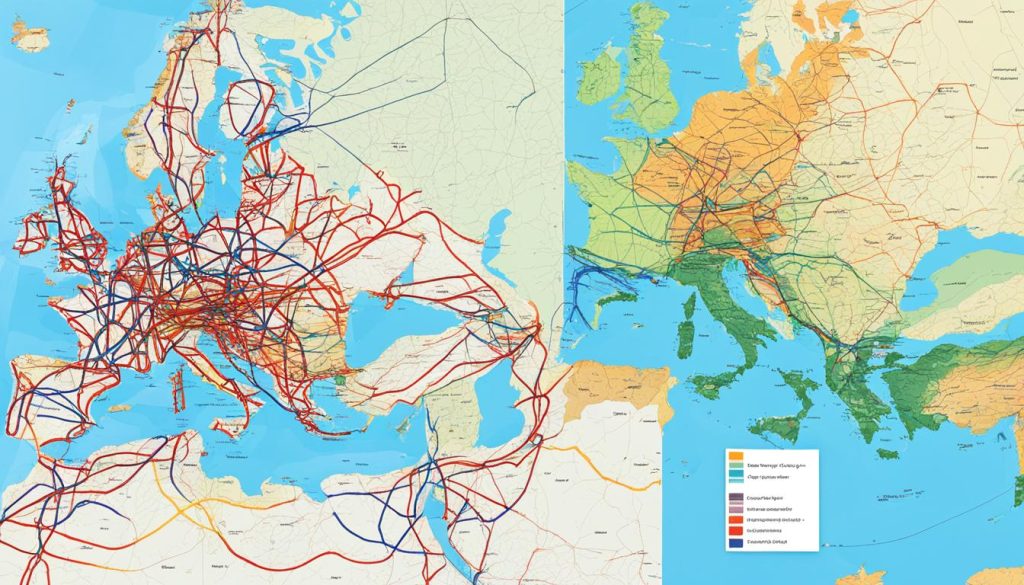
Spain is working hard to build a strong infrastructure. This includes improving transport links and energy supply. These steps are key to keeping Spain’s economy strong, despite its varied geography. Spain’s efforts show it is aiming for growth that is both sustainable and well-connected.
Transport Networks: Road, Rail and Air Connectivity
At the heart of Spain’s infrastructure efforts are its transport links. The country has a wide network of roads and railways. These connect big cities and remote areas across the Iberian Peninsula. Spain’s high-speed trains, like the AVE, make travelling between places like Madrid and Barcelona quick and efficient.
Spain’s roads and bus services ensure people and goods can move easily within the country. Also, Spanish airports, such as Madrid-Barajas Adolfo Suárez, support both local and international flights. These air connections help Spain trade globally and attract tourists.
Energy and Utilities: Sustaining Economic Activities
Spain is focusing on sustainable energy to support its economy. It is investing in renewable sources, like solar farms and wind turbines. This shows Spain’s dedication to being eco-friendly. Meanwhile, Spain keeps improving its electricity and gas services. This helps various sectors, including industry and services, meet their energy needs.
- Renewable Energy Investments: Implementation of wind and solar energy projects aimed at reducing carbon footprint.
- Modernising Infrastructure: Upgrading power grids and other utilities to ensure reliability and efficiency.
- Economic Support: Providing the necessary utilities to empower businesses and promote sustainable economic growth.
Spain’s approach to energy and utilities is more than just building infrastructure. It’s about planning for a future where the economy and environment work together in harmony.
Belgium’s Strategic Infrastructure at the Heart of Europe
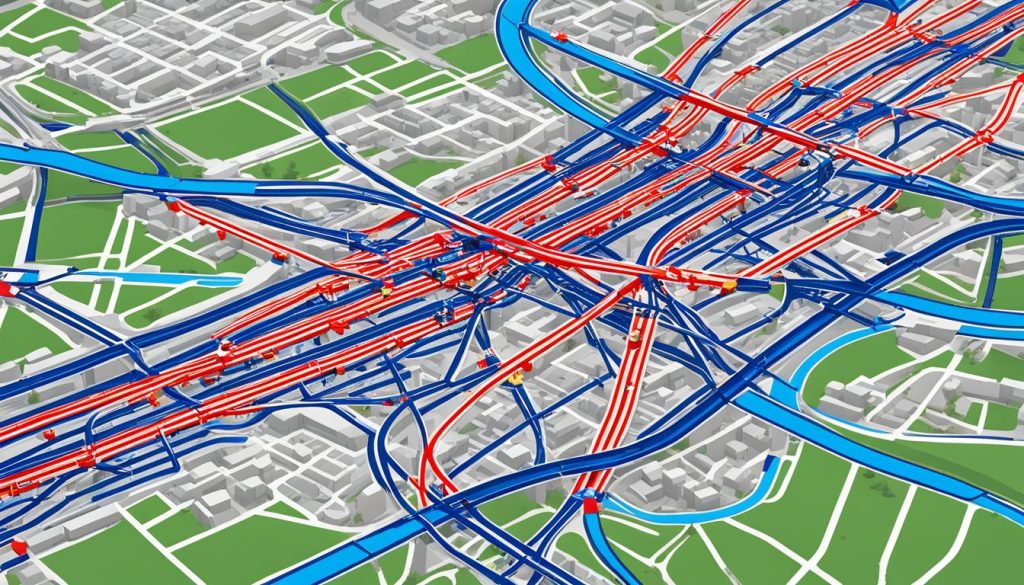
Belgium sits right at the heart of Europe’s busiest centres. Its prime location isn’t just luck; it shows its key role throughout history and today. The country’s network connects goods, people, and services. This boosts business and plays a big part in Europe’s transport system.
The country is crisscrossed by roads and railways, like veins in a body. Belgium’s rail network is especially efficient and important in Europe.
Belgium’s ports, like the huge one in Antwerp, are crucial for global trade. They boost Europe’s transport system. The Belgian waterways also support the rail and road, making transport even better.
- Belgium’s perfect location gives easy access to Western Europe’s markets.
- The mix of Belgium’s networks shows its dedication to a green, efficient Europe.
- Belgium’s facilities enhance its role as a top logistics centre in Europe.
- Trains like Thalys and Eurostar make European cities feel closer to each other.
Belgium is a buzzing hub in Europe. Its well-thought-out infrastructure highlights its vital role in wider economic and social networks.
The Unique Northern Climate and its Impact on Infrastructure
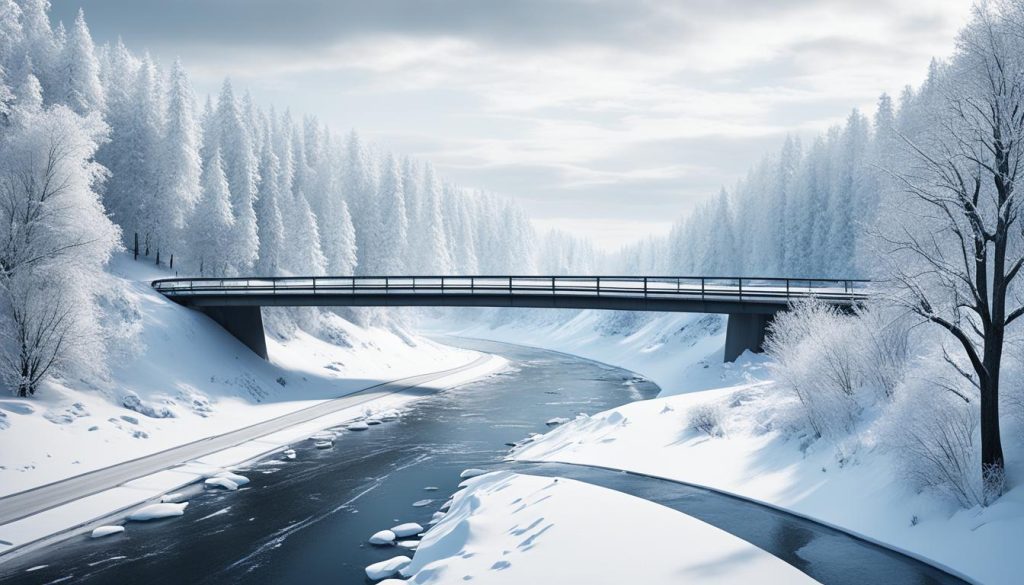
Confronting the Nordic climate, Northern Europe has become a model of creativity. It develops climate-adaptive structures to handle its harsh weather. This need for resilient systems shows human creativity against climatic challenges. The region deals with extreme cold and sudden warm spells, needing versatile infrastructure.
Buildings, roads, and public systems in the Nordics are designed to stay functional in snow, ice, and cold. Architects and engineers use advanced technologies. They make structures that are warm and withstand weather changes.
- Improved building materials keep the warmth in during winter.
- Snow-proof roofs prevent damage from heavy snow.
- Heated roads and bridges stop ice from forming, making travel safe.
- Ports have icebreakers for consistent shipping all year.
This work shows the Nordic commitment to climate-smart structures. They aim for proactive, environment-friendly infrastructure development. Their foresight is a global model for dealing with weather, pointing the way for similar projects worldwide.
- New materials and building methods improve resistance to the Nordic climate.
- Investing in green energy like wind and hydro boosts these systems.
- Smart city tech helps infrastructures quickly adjust to weather changes, protecting people.
Strict building rules, smart planning, and civil engineering make sure Northern Europe’s infrastructure can handle the climate. It mixes determination and smarts to face the Nordic weather.
Demographic Patterns and Population Distribution
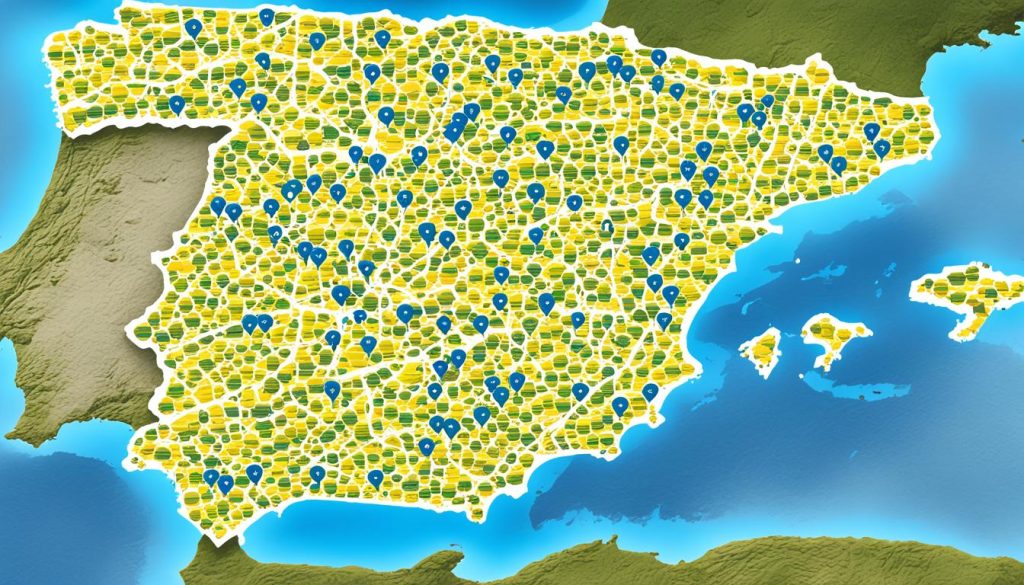
Grasping demographic trends and population distribution is key for planning the future in European countries. We explore how an aging Spanish population, population density in Belgium, and Nordic population characteristics influence their societies and infrastructure.
Spain’s Diverse and Aging Population
Spain faces an aging population. This challenges health care, pensions, and jobs. There’s a need for services and infrastructure that suit older people better.
- Ensuring accessibility in urban design for elder mobility.
- Incorporating technology in homes and communities to enhance elderly living.
- Revising healthcare services to cater to the specific needs of an older demographic.
A Dense Population Matrix in Belgium
Belgium, unlike Spain, deals with high population density due to its small area. This situation calls for smart use of space and resources, especially in crowded cities.
- Optimising public transport to alleviate urban congestion.
- Developing vertical housing solutions to utilise urban space effectively.
- Implementing green spaces strategically within urban planning to maintain environmental quality.
Population Trends in the Expansive Nordic Territories
In the Nordic countries, people live far apart across vast areas. This situation underlines the need for good connections so everyone can access services and feel included.
- Advancing digital infrastructure for remote and rural accessibility.
- Investing in sustainable transport networks connecting distant communities.
- Promoting local economies to decrease migration to urban centres.
To conclude, countries like Spain, Belgium, and the Nordics each face unique demographic challenges. They show different ways to address aging populations, crowded cities, and spread-out communities.
Impact of Geography on Cultural Evolution

Geography has deeply shaped cultures throughout history. It influences how people live and their cultural values. This connection between land and society affects cultural identity and traditions.
Nordic Countries: From Viking Ancestry to Contemporary Developments
In the Nordic countries, geography has had a clear impact. The tough land and seas led to a seafaring life from Viking times. This lifestyle created trade routes and cultural exchanges. It helped shape the Nordic identity, blending history with modern values.
Today, this history is present in education, social habits, and government. It celebrates the Nordic spirit of resilience and adventure.
Iberian Influences: Spain’s Cultural Fabric
The Iberian Peninsula shows how geography influences culture. Spain’s landscapes foster a rich, diverse society. The coast and mountains have shaped Spain’s food, architecture, and festivals.
Spain’s culture comes from centuries of different peoples living there. This mix has created a vibrant society that honors its Iberian roots.
Urbanisation and City Development: A Comparative Insight
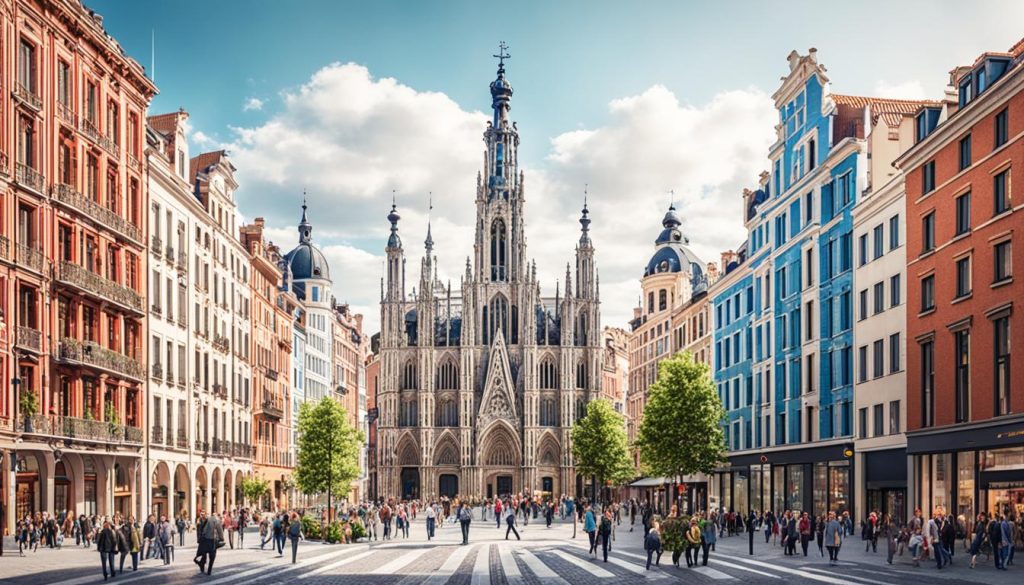
Across Europe, cities are growing and changing. This invites us to look closely at how they adapt. We are checking out how Spain, Belgium, and the Nordic Countries manage their urban growth. Each place tells a unique story about how cities in Europe develop.
Different plans have been made as these areas deal with more people and expanding cities. These plans help us see how cities can keep up with their growing populations in a sustainable way.
- These regions are trying to keep their unique feel while also growing.
- Spain’s big cities are combining living and working spaces in new ways.
- Belgium, being in the heart of Europe, focuses on connecting people and being green. This shows a strong development compared to others.
- The Nordic Countries are creating eco-friendly city areas. They value green living along with urban growth.
Looking into how fast and in what manner cities grow gives us useful data. Good planning shows that cities can evolve as more people move in. This gives us smart ideas for future city development. By learning from these stories, we can help cities grow in clever and forward-thinking ways.
Transportation Connectivity and Mobility in the Nordic Region
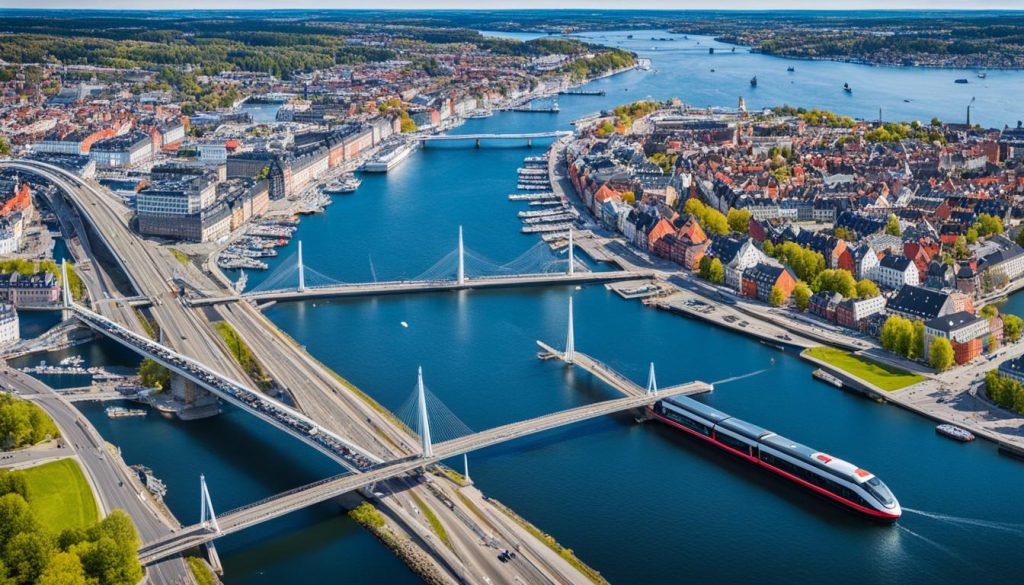
Transportation is key in the Nordic countries, linking many places and boosting the economy. It’s known for being efficient and innovative. This helps people move around the region and connects remote areas to big cities.
Linking the Nordic Islands to Mainland Europe
Nordic transport is a mix of nature and engineering across the seas. It includes bridges and tunnels that help with travel and trade. These links are more than just structures; they show a commitment to unity and access in the region.
Urban to Rural: The Diverse Transit Options
The varied landscapes of the Nordic region need different ways to travel. This ensures everyone is connected, despite tough weather. There are trains, buses, and ferries to help people move around. Everyone, including those in rural areas, becomes part of the wider community.
- State-of-the-art rail networks easing the daily commute.
- Regular ferries integrating island life with mainland opportunities.
- Bus networks extending into the heart of the rural landscape.
With these transport options, the Nordic nations are setting an example for the future. Geographical limits do not restrict quality of life here. A strong transport network is vital for a society that values connectivity and collective progress.
Assessing the Quality of Life: Spain vs. Belgium vs. Nordic Countries
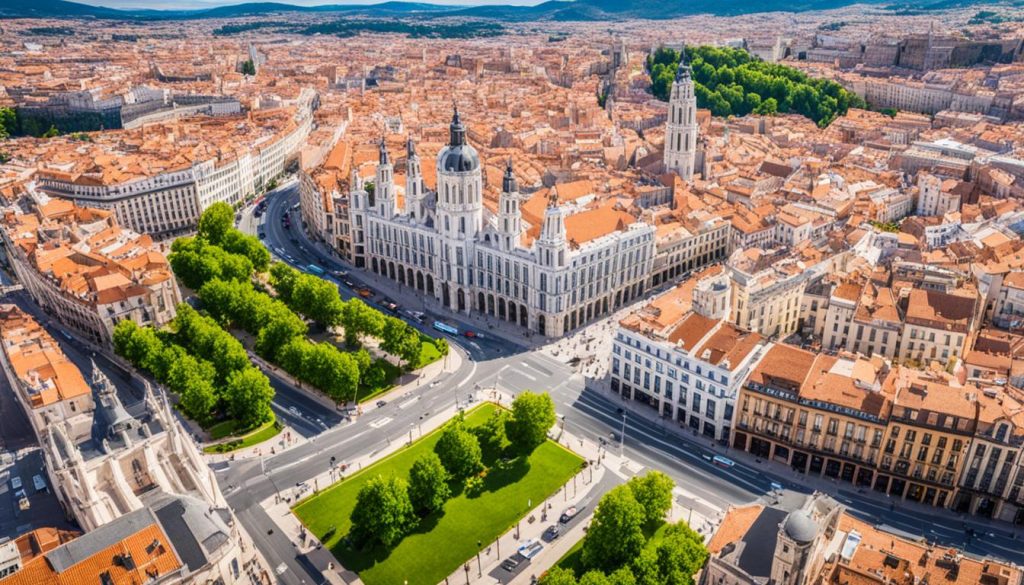
Comparing the quality of life in Spain, Belgium, and the Nordic Countries reveals many factors at play. Each country brings something unique to the table, affecting people’s happiness and wealth. Together, they show how different places across Europe offer various living standards.
The quality of life in Spain, Belgium, and Nordic Countries goes beyond just money. It includes how happy people are and how well they live. We look at key signs that tell us what ‘quality of life’ really means. These signs show us not only where these countries stand now but also what might change in the future.
- Political Stability and Civil Rights: Each country aims to protect freedoms and support democracy. This helps create a strong society, important for a good quality of life.
- Cost of Living: Looking at how much basic goods cost and how much money people have to spend tells us a lot. Spain, Belgium, and the Nordic Countries all manage this with their own approaches.
- Taxation and Social Security Systems: How people feel about taxes links closely to the benefits they get. This greatly affects how happy citizens are with their lives.
- Average Incomes and Employment Rates: The number of jobs and how much they pay show how well the economy is doing. They are crucial for people’s ability to live well and be happy.
We’ve looked at some key points that help gauge life quality in Spain, Belgium, and the Nordic Countries. Each country works hard to make life better, facing its own challenges. Although the ways they improve prosperity vary, their efforts highlight a shared goal in Europe. They aim to lift the quality of life for everyone.
Addressing Environmental Challenges Through Infrastructure
Europe is really pushing ahead with holistic sustainability. Look at how Spain, Belgium, and the Nordic Countries are tackling environmental issues. They are heavily investing in renewable energy. By doing this, they weave sustainability into their infrastructure. Their efforts are a big step towards reducing carbon footprints and building ecological resilience.
Renewable Energy Adoption and Sustainability Efforts
In these countries, the push for renewable energy is strong. Spain is big on solar and wind energy. Belgium focuses on offshore wind farms and biomass energy. The Nordic countries are making great strides with hydropower and geothermal energy. They support their sustainability with cutting-edge technology and research.
The drive for these initiatives is a deep commitment to sustainability that lasts long-term. They are merging environmental care with infrastructure development. This marks a shift away from fossil fuels to cleaner, more efficient energy solutions.
Environmental Policies and Urban Planning
- Strong green policies form a solid basis for protecting the environment and conserving resources. These rules help cut emissions and boost recycling, leading to a circular economy.
- Urban planning today aims to make cities greener. Projects are being designed to include green spaces, manage water sustainably, and build energy-efficient buildings. This way, urban spaces live in harmony with nature.
- Public transport systems are being updated to focus on low-carbon travel. This reduces the need for private cars that pollute a lot.
The mix of smart policies and urban planning helps society move towards living greener. It’s a comprehensive way to tackle the climate challenges we face.
Economic Strength and Industrial Capabilities
The world economy is like a big picture made of many pieces. Each country adds its piece with its strengths and industries. Spain, Belgium, and the Nordic countries each show how they use their resources wisely. They grow by focusing on their industries, being part of the Eurozone, and coming up with new ideas.
Spain got a big boost by joining the Eurozone. This change was huge, bringing both good things and big challenges. It made Spain rethink its industries to keep up with other European countries. Belgium, at the heart of the EU, is a key place for business and finance. The Nordic countries mix strong support for everyone with being great at business.
Spain’s Economic Landscape Post-Euro Integration
After Spain started using the Euro, things really changed. It attracted more investors and made trading easier. But, to keep up the benefits, Spain needed to change some of its ways.
Belgium as an EU Economic Hub
Belgium’s great location and top-notch transport make it really important in Europe. It’s home to European institutions and a bustling market. This makes Belgium a great place for businesses to grow and change with economic trends.
Nordic Countries: Balancing Welfare and Wealth
The Nordic countries show that you can have a strong safety net and a strong market. They offer great public services and a high quality of life but still compete globally. A mix of public and private efforts shows the Nordic way of combining freedom in the economy with caring for everyone.
Spain, Belgium, and the Nordic countries each have their own way of boosting the Eurozone’s strength. We’ve seen how their smart approaches and innovations have helped them and the whole region grow.
Technological Advancements and Digitisation Efforts
In Europe, countries like Spain, Belgium, and the Nordic Countries lead in technology and digitisation. They are turning old systems into smart, connected ones, shaping the digital age. These places aim to show what’s possible when digital meets physical.
They have made big steps in transport and energy. These efforts show how they’re improving service quality, efficiency, and sustainability.
Networking and Connectivity in a Digital Era
Key European areas are updating their connectivity to fit the digital age. We’ll see how digitisation boosts their infrastructure and helps people’s daily lives.
Digital tech brings many advantages, like better communication and smarter urban planning. This change is driving networking to new heights, essential for growth and progress.
Innovations in Transportation and Energy Production
Transport is key to modern infrastructure. Spain, Belgium, and the Nordic Countries use new tech in transport. This improves safety, speed, and environmental care.
- Electric and autonomous vehicles are cutting emissions for cleaner cities.
- Smart traffic systems make travel more efficient and less crowded.
At the same time, breakthroughs in energy are changing towards more green sources. Smart grids and renewable energy like wind and solar are key for a carbon-neutral goal.
- Smart grid tech helps use energy more efficiently.
- Solar and wind energy are now important, adding a lot to the energy supply.
In summary, Spain, Belgium, and the Nordic Countries are making big strides in tech and digitisation. Their work is a strong example for others wanting to modernise for the future. Their initiatives show a shift towards a digital, integrated, and strong future.
Healthcare Systems and Access to Medical Services
Exploring how countries look after their citizens tells us a lot about what they value. When we look at the healthcare systems in Nordic countries, Spain, and Belgium, we see different ways they ensure people can get medical care. These systems are shaped by laws, culture, and the economy, affecting how well people are served by healthcare.
Universal Healthcare Models across Nordic Countries
The Nordic countries are known for their universal healthcare. They offer a great example of health care for everyone. In these countries, health services are paid for by taxes. This means everyone can get healthcare, no matter how much money they have. This approach focuses on preventing illness and making sure everyone has equal access to care, including primary care and other health services.
Comparing Spain and Belgium’s Healthcare Infrastructures
When comparing healthcare in Spain and Belgium, both countries have wide-ranging health services. However, they approach healthcare differently. Spain has a system that covers everyone, with local control to meet specific needs. Belgium uses a compulsory health insurance to ensure a wide range of services and lets patients choose their providers. It’s important to understand these differences to grasp how well these systems meet people’s needs.
Education and Academic Infrastructure: Paving the Future
Investments in education infrastructure are crucial for a country’s growth and success. Countries like Spain, Belgium, and the Nordic nations are improving their education systems. They believe quality education shapes our future.
They aim to create learning spaces where innovation thrives. This means not only better classrooms and labs but also access to the latest technology.
These European countries show commitment through educational reforms and building upgrades. They are making their schools better places to learn and innovate.
- Implementing modernised classrooms equipped with the latest technological aids to enhance the learning experience.
- Upgrading library systems to become information hubs supporting a diverse range of disciplines.
- Creating collaborations between educational institutions, industries, and government branches to enable knowledge transfer and real-world applications of academic research.
- Fostering international partnerships to broaden perspectives and enrich the scholastic environment.
This push for better education will benefit not just these countries, but the whole world. Spain, Belgium, and the Nordic Countries show how investing in education can boost growth and development.
Conclusion
Our study looked at lots of data comparing regions. We explored Spain, Belgium, and the Nordic Countries. From Spain’s sunny areas to Belgium’s busy heart, and the Nordic fjords, we covered different places.
Spain uses its landscape well, mixing cultures and weather. Belgium may be small, but it’s strong in transport. Nordic countries use cold weather to become innovative and strong. They all adapt to their environments uniquely.
In the end, we saw both differences and similarities among these areas. They each create their own place in Europe. They show that infrastructure isn’t just about building materials. It’s also about fitting in with nature. This balance is what makes a region truly stand out.

